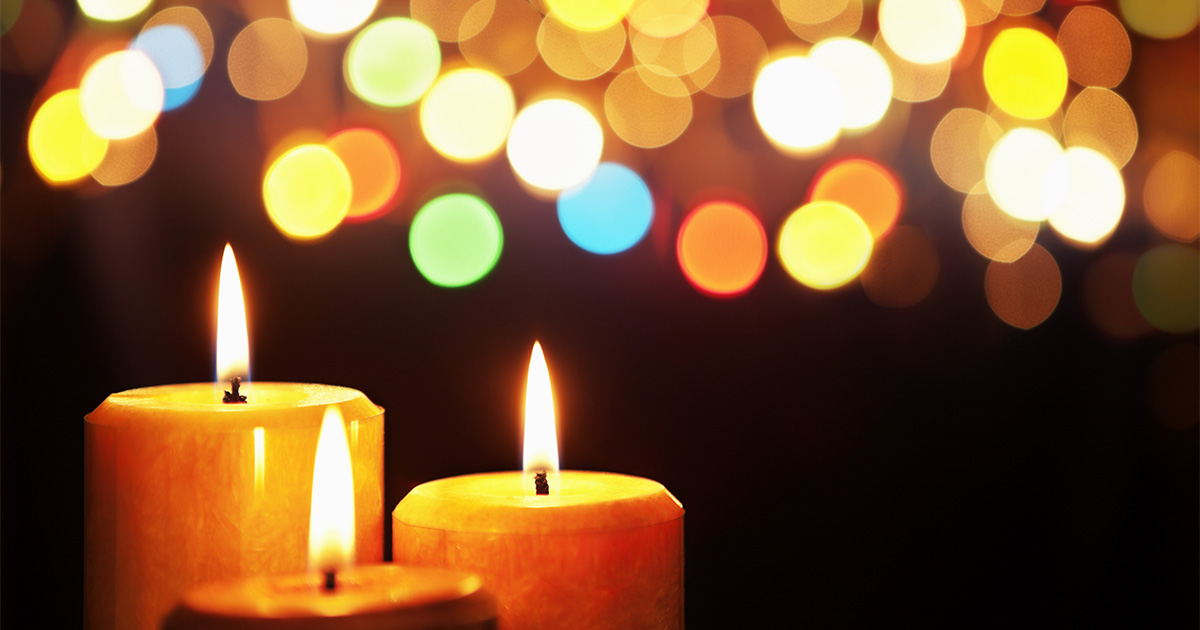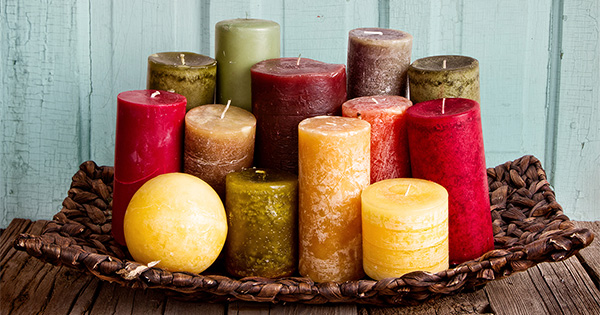
We don’t need candles. Though candles were essential technology for millennia, they’re no longer necessary to light our homes, churches, or roads—and yet they’ve retained incredible popularity. According to the National Candle Association, seven out of ten American households use candles. Over 10,000 scents are now available to customers, and U.S. retail sales of candles are estimated to be around two billion dollars a year.
Why do we love them? Nine out of ten candle users say they burn candles to make a room more “cozy” or “comfortable.” The flickering light of a candle’s tiny flame, its warm glow, its subtle aroma—all of these carry powerful, even archetypal, associations. Yet candles are for more than ambience.
They play an integral role in most religions. Many readers will be familiar with the nine-candled Hanukkah menorah, and with the custom of lighting a votive in Catholic churches. Candles also play a fundamental role in Hoodoo magic, are an object of meditation in Buddhism, and beautifully light the night for the Hindu festival Diwali. It would, in fact, be difficult to find a religion that doesn’t employ candles in one way or another.
Some religions offer clear-cut guidelines concerning candles. For example, witchcraft and hoodoo practitioners can find any number of books that dictate everything from the color of the candle to the burn time required. It may be worthwhile to investigate your own spirituality’s stance on candles.
If your religion doesn’t offer suggestions for candle use, or if you simply feel like forging your own path, then following are some methods for incorporating candles into your spiritual life.
Start simple with a basic candle meditation. You need only a candle of any size, shape, color or smell, something to light it with, and a quiet, comfortable area to sit.
Before lighting the candle, it’s useful to clarify your thoughts and intentions. What feelings do candles inspire in me? Obviously if your primary concern is the fire hazard, candle meditation is not for you. What do I hope to accomplish by lighting the candle? Though this meditation functions better when done for it’s own sake, rather than to accomplish a specific goal, it’s best to honestly confront your expectations rather than allowing them to simmer, unacknowledged, in your subconscious.
When you are comfortably seated and mentally prepared, light the candle and observe the flame. You may also wish to repeat a mantra or count your breaths. If persistent thoughts intrude, there is no need to become angry or frustrated. Simply quietly acknowledge the thoughts, then redirect your attention to the candle flame. If you are a beginning meditator, this may happen dozens of times in a single session. It is nothing to fret or stress about—in fact, doing so is deeply counterproductive. As with most things, meditation requires practice. In time, the very act of lighting the candle will ease you into a calm, restful, and clearheaded state.
Our unconscious minds are easily swayed by color, light, sound, and smell (ask any advertising exec). These subconscious associations operate powerfully behind the scenes, influencing our future actions in myriad unforeseen ways. If you have a specific goal or intention in mind, you can use the following tips to “hack” your subconscious, and enjoy an even more effective candle meditation or ritual.

Choose your candle color. Any number of books and websites offer different meanings for candle colors. Some of the most common include:
You’ll notice that some meanings include multiple colors, and some colors have completely contradictory meanings. Is blue for peace, depression, or healing? Is brown for balance, uncertainty, or money? Which meaning is true?
The answer is that they may all be—or none of them may be. For this purpose, what matters is your associations with a color. After all, you’re trying to affect your own subconscious mind, not someone else’s. What’s the point of using a rose-colored candle to promote “love” if you personally hate pink? You’ll grimace every time you see that candle, which will undermine the very emotion you’re striving for.
Black is perhaps the best example of this phenomenon. Some associate black quite powerfully with harm and negativity, even outright evil. Others perceive it as a color of dramatic renewal, the “dark of the womb.” Either way, black candles can function potently in rituals, but only if their use corresponds with your own personal color associations.
Or add color. Did you buy a candle that isn’t quite the shade you want? Simply place the candle in a colored plastic cup, and enjoy the warm glow of the color you desire. This works especially well with white tea lights. If color affects you strongly, then buying a pack of tea lights and some different colored cups lets you experiment with different shades cheaply.
Write your intentions. A study by Gail Matthews of Dominican University showed that participants who wrote down their goals accomplished more than those who did not. Incorporating a written statement of your intentions into your candle ritual will trigger the same effect.
The simplest method is to write something related to your goal on a piece of paper. This works especially well if you are praying for, or sending good energy to, another person; simply write their name, and possibly a word or two associated with the ritual (“Good health” for example), before folding the paper and slipping it beneath the candle holder. As you focus upon the candle, the same unconscious energies that improve goal-setting will enhance your concentration.
Many candle users prefer to carve their intentions upon the candle itself. This isn’t always easy, especially if your candle’s wax is brittle. Unless your goal can be easily expressed in a few characters, you’ll be better off using a sigil or religious emblem as a symbol of your purpose. Norse runes are also useful, being easier to carve than the Latin alphabet.
There is no particular best tool for carving your candle: anything from a small knife to a long sewing needle will do. One innovative, rather romantic method is to use a sharp rose thorn. Ken Biles in his article “Dressing the Candle” suggests this clever technique:
The best way I’ve found to use a rose thorn is by taking a wooden dowel, and with a drop of AC (super) glue, attaching the base of the thorn to the end of the dowel. This will give you a pencil-like grip, and because the thorn is curved, if you drag the point like a sleigh skid, you can control the direction you carve by spinning the dowel.
Similarly, using a pointed twig from an appropriate plant—willow to relieve pain, for instance—would be another way to incorporate meaningful associations.
If you’re afraid of needles, uncomfortable with knives, or don’t want to make a mess, there’s a simple alternative: paint pens. Highly recommended by Gordon in his essay “Candle Magic for the Lazy and Untalented,” paint pens offer a number of advantages. You’ll be able to write your intentions clearly upon the candle itself, you can use multiple colors to code different parts of your goal, and, if you have an artistic bent, you can even incorporate some lovely drawings or designs. However, some candle users feel that paint pens don’t offer the same “penetration” of the
ir purpose into the candle and, correspondingly, into their subconscious. As with the color of the candle, it’s simply a question of personal preference.Dress your candle. Dressing your candle refers to anointing it with oil. It can also mean rolling the candle in herbs, glitter, or both. Dressing the candle is for many a pleasant, soothing activity. Use this time to transition from daily life into the tranquil, focused state required for a candle meditation.
With oil, all that’s required is to rub a small amount up and down the length of the candle. The candle will warm the oil, releasing its fragrance as you
contemplate the flame. Either essential oils or fragrance oils will work, though many prefer the former. Some traditions specify that you start anointing the candle from the top, from the bottom, or from the middle, depending on your purpose. Plan in advance how you will apply the oil. In general, the more deliberate and contemplative your ritual is, the more benefits you will reap.You can also add herbs by rolling your candle in them, placing them in the candle’s dish, or sprinkling them over the flame. If you choose to add herbs directly to the flame, be careful! Research the plants you’ve chosen thoroughly, to be certain they’re not explosive or toxic when burned. Seeds in particular are prone to the former, so it’s best to avoid them altogether. As with everything else, you should choose herbs according to the meaning they have for you. That said, there are a number of studies documenting the physical benefits of different herbs. Rosemary, for example, has been scientifically proven to aid memory. Since evidence and statistics naturally carry great weight with most people, it’s beneficial to choose your herbs according to science.
Glitter is a popular choice for adding a touch of “magic” to your candle. In this case, it’s best to stick to rolling the candle in glitter, perhaps after dressing it with oil. Adding glitter to the flame itself could be dangerous and is unlikely to smell very nice.
Remember, candle rituals work best when they’re customized to your subconscious, so don’t be afraid to make changes to the steps below.